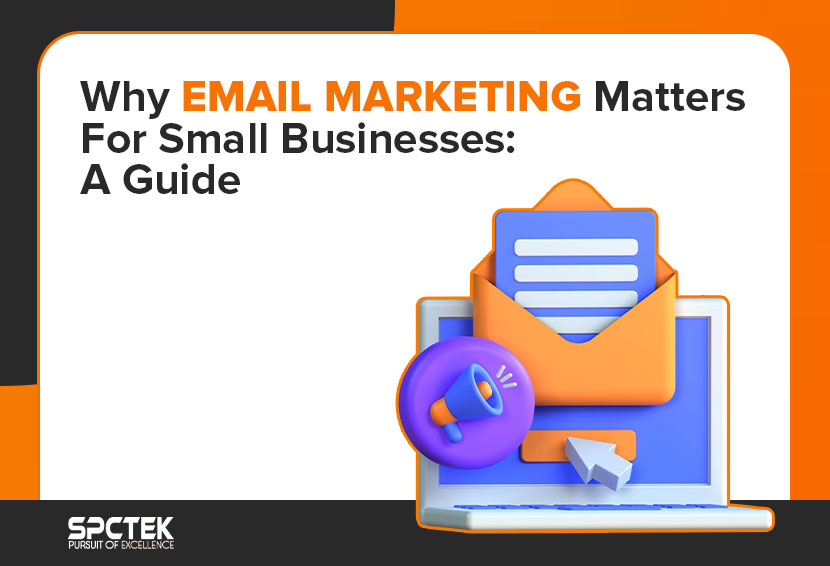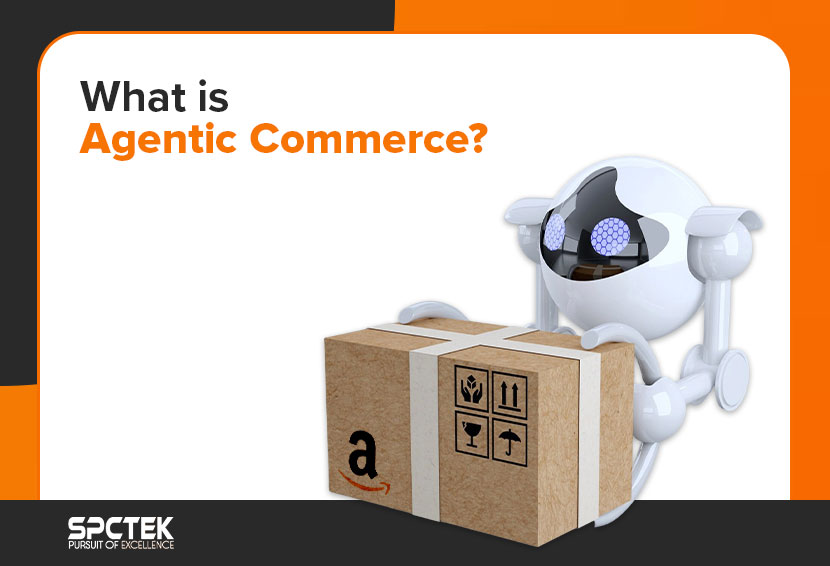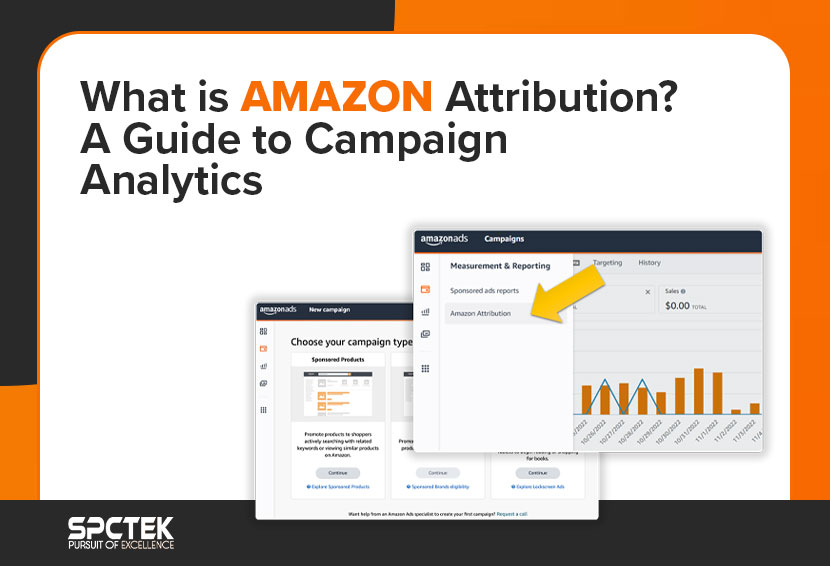Too busy to read? We’ve got audio.
Email marketing remains one of the most effective tools in the digital marketing world. This blog will explore what email marketing is, why email marketing is essential for small businesses, its advantages, how to track success, the best tools to use, and proven strategies to make the most of your campaigns.
What is email marketing?
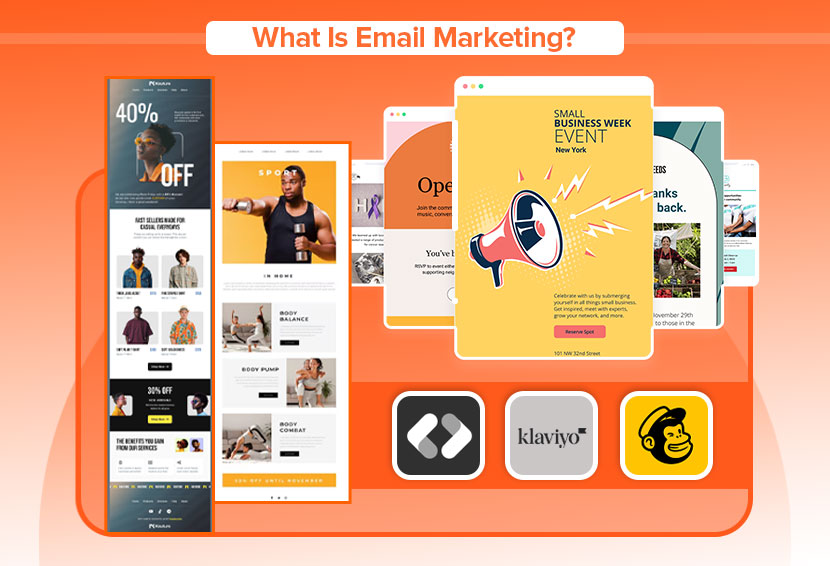
Email marketing is a digital marketing strategy that consists of sending emails to a target audience to sell or promote services and products, build brand awareness, educate the audience, and strengthen customer relationships.
Email marketing involves sending various types of marketing emails, such as newsletters, promotions, product launches, welcome messages, etc., to a list of subscribers who opted in to receive them. The direct and targeted nature of email marketing makes it a key tool in the digital marketing toolkit.
Why is email marketing essential for small businesses?
Creating meaningful connections with customers can be difficult, especially for small businesses with limited budgets and small teams. So, why use email marketing? Because it’s one of the most cost-effective ways to build relationships, promote your brand, and drive growth.
Email marketing allows you to reach your audience directly with personalized and relevant messages. You can tailor your content to match customer interests, send targeted promotions, and use data to refine your approach over time. This ensures every message feels valuable and timely.
Automation tools make things even easier by saving time while keeping your communication consistent. Instead of manually sending each update, you can set up automated campaigns that welcome new subscribers, share helpful content, and encourage repeat purchases.
The power of email marketing for small businesses goes beyond just increasing sales. One of its most important features is that it helps you build trust, educate, and turn satisfied buyers into loyal customers.
What Are the Email Marketing Advantages for SMBs?
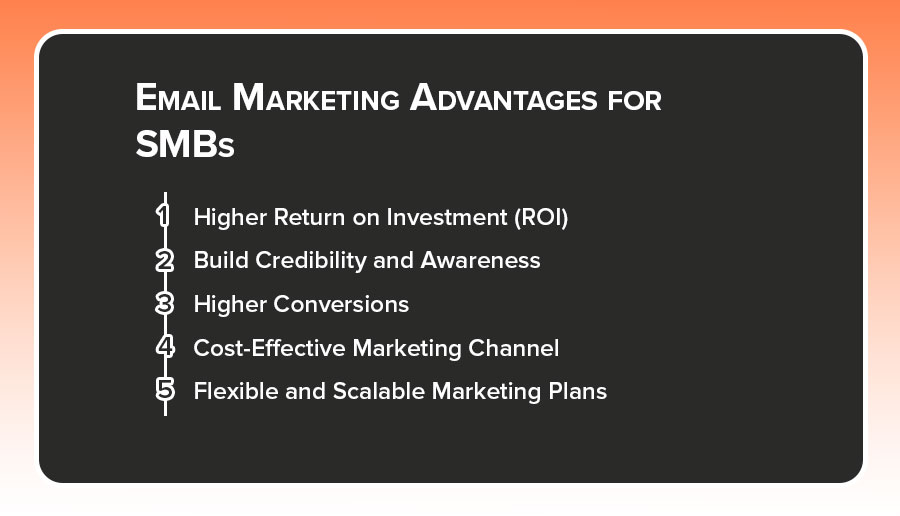
Email marketing is a must for Small and Medium-sized Businesses (SMBs) in today’s marketing landscape. Emails provide a direct and affordable way to grow brand awareness, customer base, loyalty, and consistent sales.
1. Higher Return on Investment (ROI)
One of the biggest advantages of email marketing for SMBs is its exceptional return on investment. Email marketing is still one of the best ways to connect directly with your customers and drive traffic to your website. It consistently outperforms social media in terms of engagement and conversion rates due to its personalized nature and the higher intent of subscribers. Research shows that, on average, every dollar spent on email marketing can generate around $36 to $40.
2. Build Credibility and Awareness
One of the key email marketing benefits for SMBs is the ability to establish brand credibility. When your small business consistently delivers useful and high-quality content, it positions your company as an authority in your industry.
The more your customers engage with your emails and find them helpful, the more they trust your brand. Research shows that most consumers prefer buying from brands they recognize and are familiar with.
3. Higher Conversions
When used correctly, email marketing is a powerful sales driver. Promotional emails make it easy for customers to buy directly from their phones or computers. Whether you’re announcing new products, offering limited-time deals, or sharing personalized recommendations, email marketing can increase both immediate and long-term sales.
The email marketing helps SMBs:
- Convert leads into paying customers
- Upsell or cross-sell existing clients
- Reconnect with inactive customers
- Encourage repeat purchases and referrals
Targeted, relevant emails increase the likelihood that subscribers will take action and make a purchase.
4. Cost-Effective Marketing Channel
When compared to print, display, or social media advertising, email marketing is far more affordable. You don’t need to pay for printing, postage, or ad space, just a monthly fee for your email marketing platform.
This makes email marketing one of the most cost-effective marketing methods for small and medium-sized businesses. You can reach thousands of potential customers at a fraction of the cost of other channels, making it a smart choice for SMBs on a budget.
5. Flexible and Scalable Marketing Plans
Budget flexibility is another strong email marketing advantage for SMBs. Many email marketing platforms offer scalable plans, allowing you to start small and grow as your audience and business expand. This flexibility means you can invest according to your current needs without overspending, making it ideal for small businesses looking for affordable yet impactful marketing solutions.
How Can Small Businesses Get Started With Email Marketing?
If you’re thinking about how to get started with email marketing, creating an effective email strategy involves four key elements:
- Building an audience/subscriber list
- Planning the types of emails to send
- Creating copy and design
- Running the campaign and tracking results
1. Building an Audience/Subscriber List
To get started with email marketing, the first step is building your contact list. After all, your efforts won’t matter if there’s no one to send your emails to.
Start by creating a signup form and featuring it prominently on your website, blog, and social media. For best results, use a double opt-in sign-up form, which sends a confirmation email after someone subscribes.
2. Decide What Types of Emails to Send
Once you have a growing list, decide what kinds of emails you’ll send. The right mix depends on your business type, but it’s always good to start with a monthly email newsletter.
You can also send other types of email, including:
- Promotional emails for sales or special offers
- Seasonal messages for holidays or events
- Personalized discounts for loyal customers
- Transactional messages like receipts or appointment reminders
- Product emails highlighting features and benefits
Starting simple helps you stay consistent while learning what resonates best with your audience.
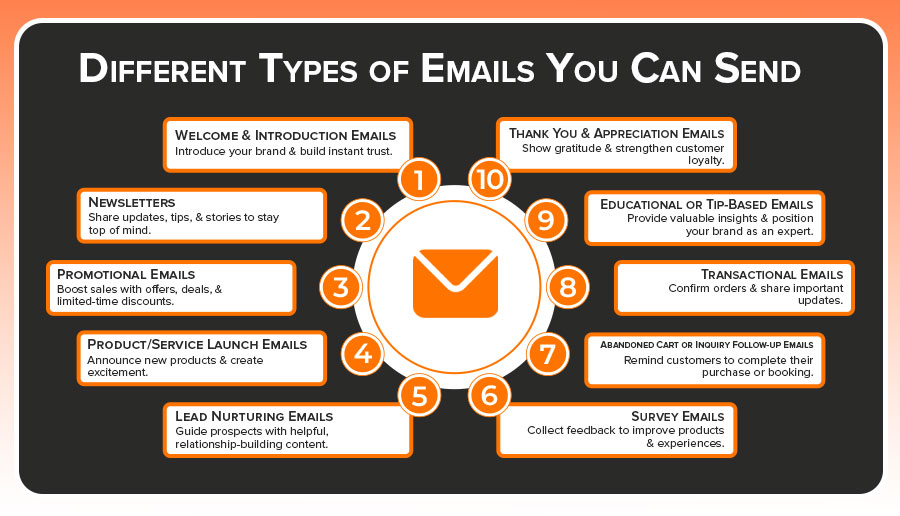
3. Create Your Email Design and Content
Don’t worry if you’re not a designer. Most email marketing tools offer easy drag-and-drop editors that make creating professional emails simple. Keep your design clean, consistent with your brand, and easy to read.
Your content should always focus on the customer, what they care about, and what value you can offer. To do this well, segment your contact list based on shared interests or behaviors. Focus on a single call to action (CTA) that clearly tells readers what to do, such as ‘Read More,’ ‘Shop Now,’ or ‘Get Your Discount.’ Avoid multiple CTAs in one email to prevent confusion.
4. Send and Analyze Your Campaign
Your job isn’t done once you hit “Send.” The real power of email marketing lies in tracking performance and learning from it. Monitor key metrics such as open rate, click-through rate (CTR), conversion rate, etc. Reviewing these insights helps you understand what works and fine-tune future campaigns for better results.
How to Track Small Business Email Marketing Success?
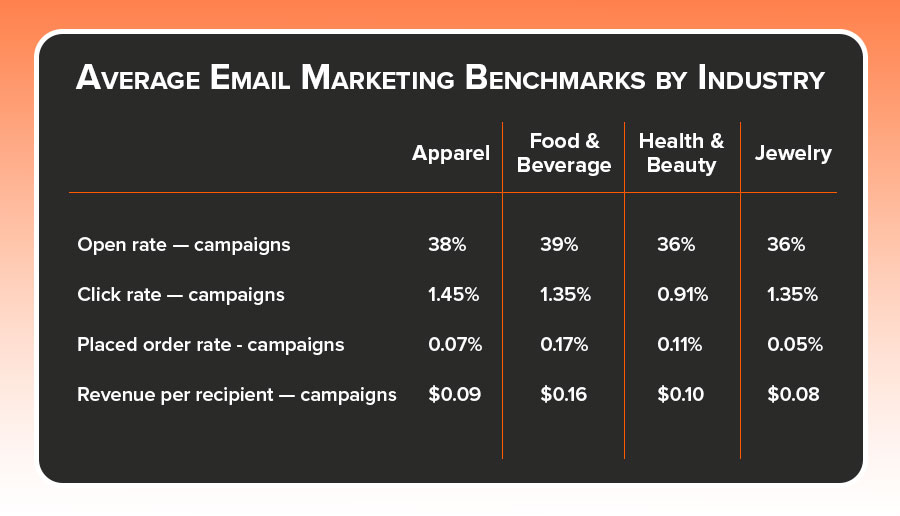
Tracking your results helps you understand what’s working and where to improve. Some of the key metrics every small business should monitor include open rate, click rate, subscription rate, conversions, and deliverability. The following are the metrics that are crucial to track:
- Open Rate: This is the most important metric because it measures the percentage of emails that are opened by the audience. A high open rate means that more users are opening your emails, showing that the subject lines, messaging, and deliverability are on point.
- Click Rate: This measures whether the reader clicks on any clickable element, such as a link or CTA, in the email after opening it. A higher click rate shows that more readers are taking the desired action by opening the links or clicking on the CTAs.
- Subscription Growth: Your subscriber list is like your community. The more it grows, the wider your reach. Simple tactics like adding a sign-up form to your website, offering exclusive perks, or promoting through social media can expand your audience. In small business email marketing, this growth is key to long-term success.
- Conversions: Conversions measure how many readers take action. Whether it’s making a purchase, booking a service, or downloading a guide. Test different call-to-action buttons, visuals, copies, and offers to see what works best.
- Revenue Per Recipient (RPR): This metric shows how much income each email generates per recipient. It helps you understand the true financial impact of your campaigns. Tracking RPR lets you identify which messages or offers drive the most revenue.
- Deliverability Rate: Deliverability measures how many of your emails actually reach your audience’s inbox. A high deliverability rate ensures your hard work doesn’t end up in spam folders. Keep your contact list clean, avoid spammy subject lines, and use a trusted email service provider to maintain a strong sender reputation.
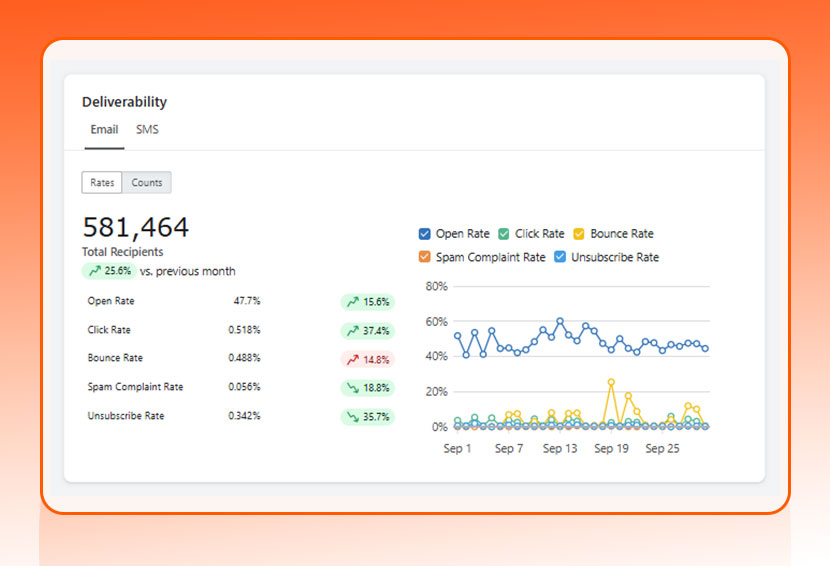
- Unsubscribe Rate: Your unsubscribe rate shows how many people opt out of your emails. A slight number is normal, but if it’s rising, it’s a sign to adjust your approach. Review your content frequency, relevance, and tone. In email marketing for small businesses, retaining subscribers is just as important as gaining them.
Best Email Marketing Platforms for Small Businesses: Free and Paid Options
Before choosing an email marketing platform, it’s important to evaluate
What to Look for in an Email Marketing Platform?
You should consider several key factors when evaluating tools for small business email marketing. These factors include subscribers and send limits, customization options, automation, and responsiveness.
1. Subscriber and Send Limits
Email marketing platforms vary widely in how many monthly email sends and subscribers they allow in their monthly plans. The most useful options provide at least 1,000 subscribers and a reasonable number of sends per month, ensuring small businesses can run meaningful campaigns without spending too much.
2. Templates, Customization Options, and Device Responsiveness
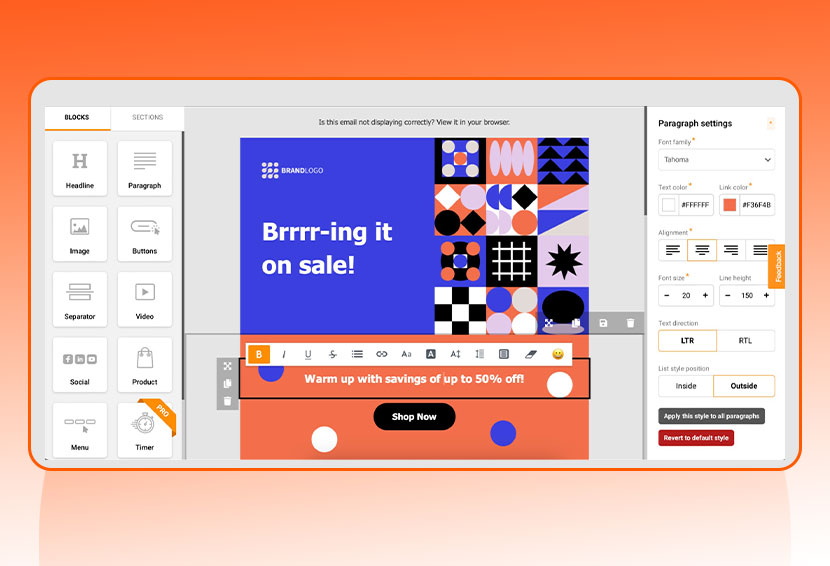
Strong email marketing software should include professionally designed templates to simplify campaign creation. For platforms that lack prebuilt templates, an intuitive email editor with drag-and-drop functionality is essential to help users easily create branded, high-quality messages. Also, ensure that the email platform offers responsiveness on a wide range of devices, including mobile and tablet.
3. Audience Segmentation and Automation
Effective email marketing for small businesses depends on reaching the right audience at the right time. See if the email platform offers audience segmentation and automation tools that enable you to send targeted emails that drive better engagement.
4. Comprehensive Email Marketing Features
Some tools focus on specific use cases such as newsletters or transactional emails. However, the most effective platforms for small business email marketing support the full spectrum of marketing needs, from newsletters and promotions to automated workflows and customer nurturing.
Free Email Marketing Platforms for Small Businesses
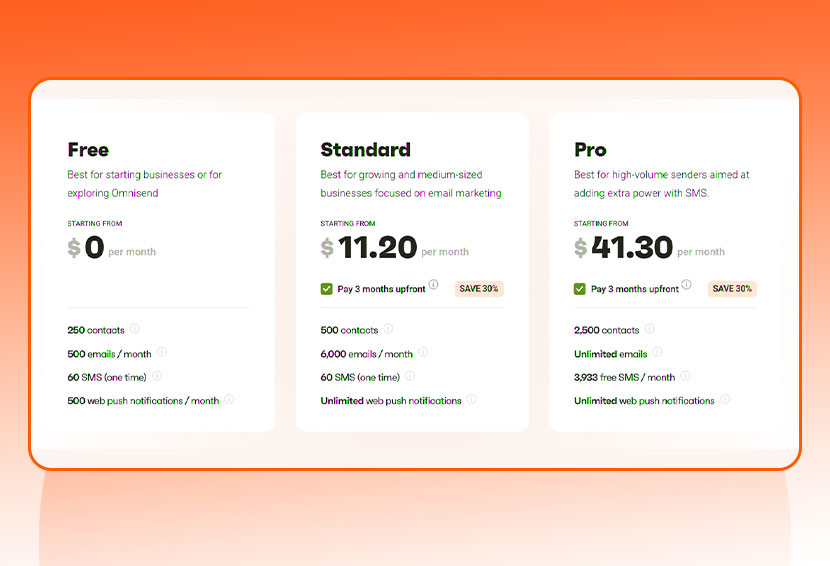
For small business owners starting out, these free tools provide reliable features and flexibility without requiring an upfront investment:
- MailerLite: User-friendly design and automation make it a solid option for small business email marketing beginners.
- Brevo: Combines email and SMS marketing, offering scalability as a business grows.
- Kit: Tailored for eCommerce and small online stores with AI-powered automation.
- Sender: Provides generous free limits and strong deliverability for startups and local businesses.
- Loops: A clean, modern platform suited for minimalistic email campaigns.
- EmailOctopus: Affordable and simple, with easy integration for small business tools.
- Audienceful: Ideal for creators and service-based businesses focusing on content-driven email marketing.
- Omnisend: Great for eCommerce brands combining email, SMS, and automation.
Best Email Marketing Platforms for Small Businesses
As your business grows, more advanced features and scalability become important. These platforms offer both free and paid plans to support long-term growth in small business email marketing:
- Klaviyo: Efficient segmentation with great automation and revenue tracking features.
- Moosend: Affordable, feature-rich, and easy to use with strong automation.
- Mailchimp: A well-known choice offering analytics, segmentation, and brand customization.
- Constant Contact: Great for businesses that value customer support and event management tools.
- HubSpot: Combines CRM capabilities with powerful email marketing features.
- ActiveCampaign: Excels at personalization and automation for growing businesses.
- Brevo: Also ideal for scaling from free to paid as marketing needs expand.
Best Practices and Strategies for Effective Small Business Email Marketing
Inboxes are more crowded than ever. Your audience receives countless messages from companies every day, so you need a clear plan to stand out. These best practices for email marketing for small businesses will help you get noticed, build trust, and grow lasting relationships with your subscribers.
1. Personalization and Segmentation
Small businesses often work with tight budgets and small teams, which can make it challenging to build and maintain customer loyalty. One powerful and efficient way to do this is through personalized emails for small businesses, which help create meaningful connections and support steady growth.
Personalization means crafting messages that speak directly to each customer and add value, while segmentation groups your audience based on their interests or behaviors. Together, they ensure your messages feel relevant and timely.
For example, you can segment your audience by:
- Demographics (gender, age, location)
- Purchase history (preferred product/service categories, number of purchases, etc.)
- Brand loyalty (new leads, longtime customers, VIPs, etc.)
Automated email drips can then handle tasks such as welcome messages, helpful tips, and special promotions that help keep customers engaged without requiring constant attention. You can use AI tools to analyze customer behavior and automatically refine your segments. This allows you to deliver smarter and more targeted messages.
2. Write Subject Lines That Get Clicks
Your subject line is the first impression your reader gets. Keep it short, specific, and relevant to what your email offers. Personalizing subject lines with your customer’s name or interests can boost open rates. To make your campaigns stronger, ask new subscribers what kind of content they want when they join your list. That way, your email marketing for small businesses stays relevant and customer-focused.
3. Grow List With Convenient Sign-ups
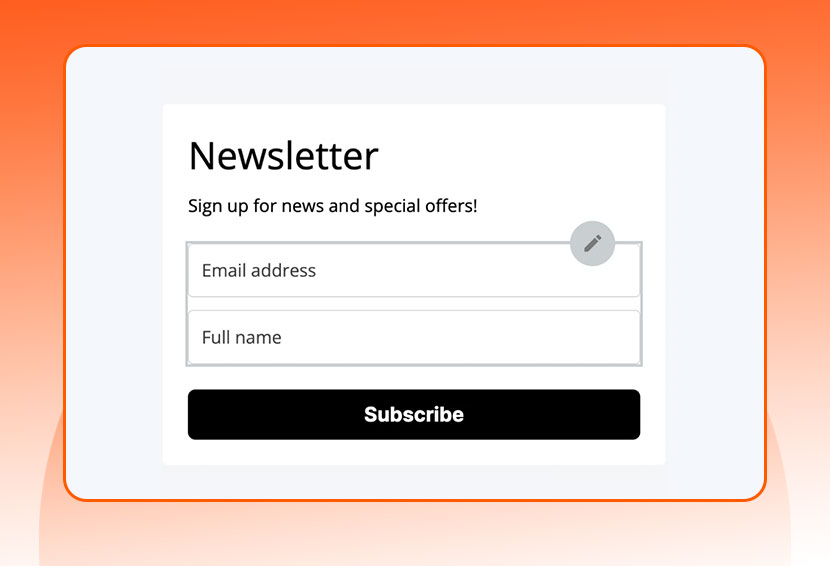
Grow your list by placing sign-up forms in key spots across your website, such as your homepage, contact page, and footer. To maximize visibility, place your signup forms in high-traffic areas: your homepage, blog sidebar, social media bios, or even your email signature.
If you run an online store, add an opt-in option at checkout. Brick-and-mortar stores can use a simple clipboard or tablet to gather emails at the counter. These sign-up opportunities keep your small business email marketing efforts consistent and effective.
4. Reward and Engage Your Most Loyal Readers
Some subscribers are highly engaged and open your emails often. Create a separate list for these customers and offer exclusive deals, early access, or insider updates. This approach strengthens loyalty and increases conversions, which is an important goal in small business email marketing.
5. Automate Your Email Campaigns
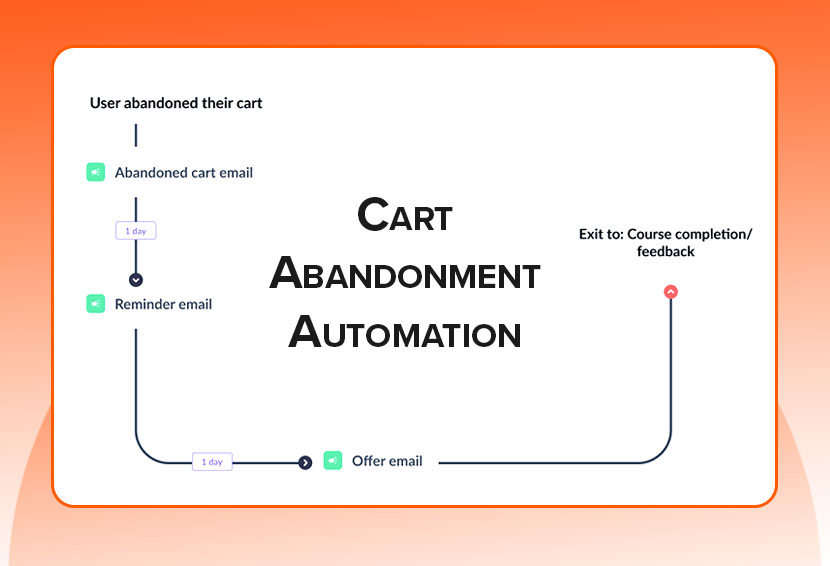
Automation saves time while keeping your communication consistent. Start with a welcome email for new subscribers to introduce your business and set expectations. You can also send follow-ups based on customer actions, such as suggesting related products or reminding them about items left in their cart. Automating your email marketing for small businesses helps maintain strong relationships without constant manual effort.
6. Ensure Every Email Is Accessible
Accessibility means making sure everyone, including people with visual or cognitive impairments, can read your emails easily. Use short paragraphs, clear fonts, and simple language. Add ALT text for images, use headers for structure, and choose colors that provide good contrast.
7. Design Emails That Work on Every Device
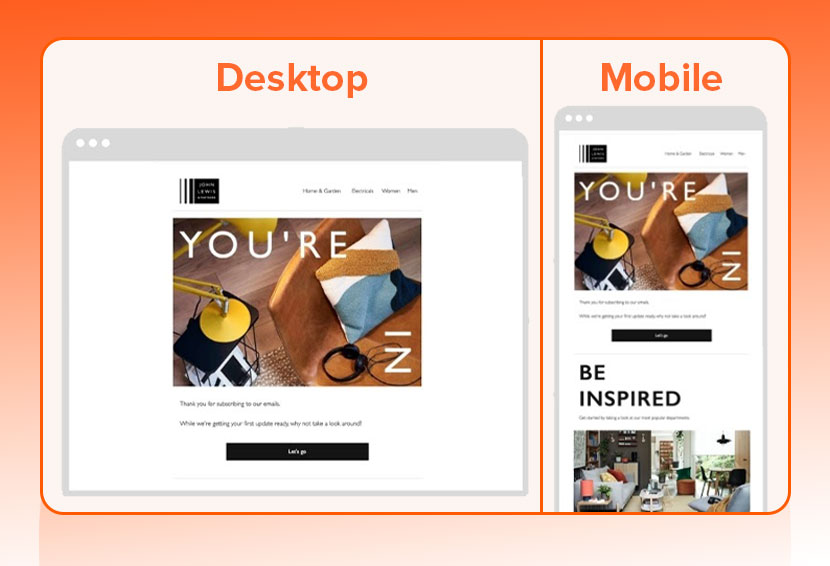
Almost half of all emails are opened on mobile phones. That means your email design must be responsive and easy to read on any screen. Use tools or templates that adjust your layout for phones, tablets, and desktops. A mobile-friendly design ensures that your email marketing for small businesses delivers a great experience every time.
8. Keep Your Promise to Subscribers
Subscribers trust you when they share their email address, so honor that trust. Send the type of content and frequency you promised. If you offered a monthly newsletter, send it on schedule and stay true to your theme. Consistency builds credibility and keeps your emails trustworthy.
9. Ask Subscribers to Add You to Their Contacts
Improve deliverability by asking new subscribers to add your email address to their contact list. Include this request in your welcome email. For Gmail users, suggest dragging your email from the Promotions tab to the Primary tab. This simple step helps ensure your emails reach the main inbox every time.
10. Test Everything Before Sending
Before launching your campaign, test it. Preview your emails on different devices and send test versions to yourself or your team. Check for typos, design issues, or broken links. Run A/B tests on subject lines or call-to-action buttons to see what performs best. Testing is one of the most valuable steps in email marketing for small businesses because it helps you send professional, polished messages.
Final Thoughts
Email marketing remains one of the smartest and most reliable tools for small businesses to grow sustainably. Its affordable, data-driven, and relationship-focused nature helps you reach customers directly with messages that matter.
Whether you’re a local shop or an online brand, mastering email marketing can improve engagement, loyalty, and revenue. Start small, stay consistent, and let your emails become the voice that builds lasting customer relationships.
Got More Questions?
A: Email marketing can help small businesses grow brand awareness, build a loyal customer base, and increase sales. This can be achieved by creating targeted campaigns that resonate with the audience and provide relevant value.
A: Small businesses can start by creating an audience or subscriber list through website and social media sign-ups. Then they need to plan what kind of emails they want to send. They can start testing with free platforms and then purchase the one that suits their needs.
A: Email marketing provides a personalized and direct channel to reach high-intent audiences. The targeted nature and cost-effectiveness of email marketing make it the cornerstone of digital marketing.
A: Missing out on email marketing can lead to missed sales opportunities, weak customer relationships, and a lack of brand awareness and visibility.
A: The common email marketing mistakes include improper segmentation, irrelevant messaging, inconsistent frequency, no clear CTA (or too many CTAs), and weak or misguiding subject lines.

